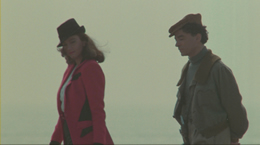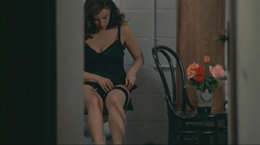

Following the long, destructive process of making Caligula for The plot of The Key is dervied from the novel Kagi by Jun'ichirô Tanizaki, which has been adapted numerous times including 1959's Odd Obsession by Kon Ichikawa and another little seen version made the same year in '83 by Akitaka Kimata. The original 1956 novel was written in diary form between the husband and wife, with a sexual frankness that made it one of the more controversial works for the author (who also wrote the often-filmed Manji).
In quite a scandalous role at the time, Stefania Sandrelli (a veteran of Bernardo Bertolucci films like The Conformist and 1900 as well as Black Belly of the Tarantula) stars as Teresa Rolfe whose much older husband, Nino (British film vet Finlay), encourages his aging libido by pushing his wife into an affair with their studly future son-in-law, Laszlo (Branciaroli). It's all set into motion when Nino deliberately leaves out his diary containing jealous thoughts and fantasies, pushing his wife into a string of sexual adventures. Needless to say, Nino's fascist-sympathizing daughter, Lisa (Stage Fright's Cupisti), is no match in the sack but has own role to play in their mind games.
Arguably the classiest of Brass's films, The Key sports a lush period setting in pre-World War II Venice, with Mussolini's rise to power mirroring the increasing decadence of the characters. The vintage setting proved to be ideal for his cinematic style, and he Almost every country got to see this film before America, who came very late to the game after gray market copies were traded around for years. The film was officially released on DVD in virtually identical transfers in both the US and UK in the early 2000s, letterboxed at 1.66:1. For some reason both DVDs claimed to be 16:9 enhanced, but neither actually were. The US Cult Epics transfer incorporated about 12 minutes of Italian dialogue which was trimmed from English prints, and a remastered anamorphic version was eventually released as part of the label's discontinued Tinto Brass Collection box set. The Cult Epics disc also contains a hefty 17-minute video interview with Brass, a photo gallery, filmographies for Brass and Sandrelli, and the original European trailers for this film, Miranda, and All Ladies Do It, the last of which is mostly a very funny conversation between Brass and his leading lady.
The 2013 dual-format UK release from Arrow contains a Blu-Ray edition that obviously raises lots of questions about which version might be contained inside. As it turns out, it's pretty much all good news here with one big surprise. The longest English-friendly release on video before this ran 105 minutes, while the Blu-Ray clocks in at 110. The obvious conclusion would be a lack of PAL speed correction on the Cult Epics release, but in fact, the Blu-Ray really does have even more footage and contains numerous relatively explicit shots including a lot of Branciaroli's prosthetic phallus, a device that would become common in the director's later films to get around censors. Both the Italian and English versions are finally both included at once, with newly translated English subtitles for the Italian version and brief segues to subtitles on the English track where only Italian dialogue was recorded. The Italian audio is in better shape and serves the film better, so go with that one if possible. Also included are the original trailer, reversible cover art with the original poster art on the back, and liner notes by encyclopedic Brass expert Alexander Tuschinski. As for the transfer itself, the 1.78:1 framing actually turns out to be a blessing (and the exact opposite of Arrow's simultaneous, problematic release of All Ladies Do It) as it features considerable extra visual information on the left and right sides as well as a sliver more on top, losing only a very minor shred at the bottom. The blacks aren't quite as deep as the Cult Epics version, but you can easily tweak that with your TV settings. For a comparison, check out this shot from the Blu-Ray compared to this one from the Cult Epics DVD. Update: thanks to Eric Cotenas for pointing out that the most recent 2009 Raro release in Italy (their third!) contains yet an even longer version with another restored scene involving Finlay. This might actually rival Caligula for the most versions of any Brass film!
Directed by Tinto Brass
Starring Stefania Sandrelli, Frank Finlay, Fraanco Branciaroli, Barbara Cupisti
Arrow (Blu-Ray & DVD) (UK RB/R2 HD/PAL) / WS (1.78:1) (16:9), Cult Epics (US R0 NTSC), Raro (Italy R0 PAL) / WS (1.66:1) (16:9)
 Penthouse in the late 1970s and engaging in various legal battles, director Tinto Brass took a while to find his footing again. He was primarily known for his experimental counterculture films, but the success of his earlier Nazi shocker Salon Kitty had proven his ability to blend extreme sexuality with visual opulence. That turned out to be the path he would follow for the rest of his career, first attempting a nonlinear erotic comedy with Action in 1979 and then finally scoring a hit in 1983 with The Key. The tantalizing blend of '40s Italian style and bold, graphic sexuality made it one of his strongest films, creating a template he would follow for many future films to come.
Penthouse in the late 1970s and engaging in various legal battles, director Tinto Brass took a while to find his footing again. He was primarily known for his experimental counterculture films, but the success of his earlier Nazi shocker Salon Kitty had proven his ability to blend extreme sexuality with visual opulence. That turned out to be the path he would follow for the rest of his career, first attempting a nonlinear erotic comedy with Action in 1979 and then finally scoring a hit in 1983 with The Key. The tantalizing blend of '40s Italian style and bold, graphic sexuality made it one of his strongest films, creating a template he would follow for many future films to come.
 returned to it several more times including his later underrated classic Senso '45. The visual potency is enhanced by Sandrelli, giving her all with an uninhibited and often undraped performance, and a catchy Ennio Morricone score that set the tone for future bouncy
returned to it several more times including his later underrated classic Senso '45. The visual potency is enhanced by Sandrelli, giving her all with an uninhibited and often undraped performance, and a catchy Ennio Morricone score that set the tone for future bouncy  Brass music to come.
Brass music to come.
Updated review on May 18, 2013.
![]()